§ 20‑124. Brakes.
(a) Every motor vehicle when operated upon a highway shall be equipped with brakes adequate to control the movement of and to stop such vehicle or vehicles, and such brakes shall be maintained in good working order and shall conform to regulations provided in this section.
(b) Repealed by Session Laws 1973, c. 1330, s. 39.
(c) Every motor vehicle when operated on a highway shall be equipped with brakes adequate to control the movement of and to stop and hold such vehicle, and shall have all originally equipped brakes in good working order, including two separate means of applying the brakes. If these two separate means of applying the brakes are connected in any way, they shall be so constructed that failure of any one part of the operating mechanism shall not leave the motor vehicle without brakes.
(d) Every motorcycle and every motor‑driven cycle when operated upon a highway shall be equipped with at least one brake which may be operated by hand or foot.
(e) Motor trucks and tractor‑trucks with semitrailers attached shall be capable of stopping on a dry, hard, approximately level highway free from loose material at a speed of 20 miles per hour within the following distances: Thirty feet with both hand and service brake applied simultaneously and 50 feet when either is applied separately, except that vehicles maintained and operated permanently for the transportation of property and which were registered in this or any other state or district prior to August, 1929, shall be capable of stopping on a dry, hard, approximately level highway free from loose material at a speed of 20 miles per hour within a distance of 50 feet with both hand and service brake applied simultaneously, and within a distance of 75 feet when either applied separately.
(e1) Every motor truck and truck‑tractor with semitrailer attached, shall be equipped with brakes acting on all wheels, except trucks and truck‑tractors having three or more axles need not have brakes on the front wheels if manufactured prior to July 25, 1980. However, such trucks and truck‑tractors must be capable of complying with the performance requirements of G.S. 20‑124(e).
(f) Every semitrailer, or trailer, or separate vehicle, attached by a drawbar or coupling to a towing vehicle, and having a gross weight of two tons, and all house trailers of 1,000 pounds gross weight or more, shall be equipped with brakes controlled or operated by the driver of the towing vehicle, which shall conform to the specifications set forth in subsection (e) of this section and shall be of a type approved by the Commissioner.
It shall be unlawful for any person or corporation engaged in the business of selling house trailers at wholesale or retail to sell or offer for sale any house trailer which is not equipped with the brakes required by this subsection.
This subsection shall not apply to house trailers being used as dwellings, or to house trailers not intended to be used or towed on public highways and roads. This subsection shall not apply to house trailers with a manufacturer's certificate of origin dated prior to December 31, 1974.
(g) The provisions of this section shall not apply to a trailer when used by a farmer, a farmer's tenant, agent, or employee if the trailer is exempt from registration by the provisions of G.S. 20‑51. This exemption does not apply to trailers that are equipped with brakes from the manufacturer and that are manufactured after October 1, 2009.
(h) From and after July 1, 1955, no person shall sell or offer for sale for use in motor vehicle brake systems in this State any hydraulic brake fluid of a type and brand other than those approved by the Commissioner of Motor Vehicles. From and after January 1, 1970, no person shall sell or offer for sale in motor vehicle brake systems any brake lining of a type or brand other than those approved by the Commissioner of Motor Vehicles. Violation of the provisions of this subsection shall constitute a Class 2 misdemeanor. (1937, c. 407, s. 87; 1953, c. 1316, s. 2; 1955, c. 1275; 1959, c. 990; 1965, c. 1031; 1967, c. 1188; 1969, cc. 787, 866; 1973, c. 1203; c. 1330, s. 39; 1993, c. 539, s. 359; 1994, Ex. Sess., c. 24, s. 14(c); 2009‑376, ss. 10, 11.)


 If you don't slack off a little in every aspect in this economy, people are going to go elsewhere. Seems every buisness a person can walk into to get something done is being re-defined right now.
If you don't slack off a little in every aspect in this economy, people are going to go elsewhere. Seems every buisness a person can walk into to get something done is being re-defined right now.